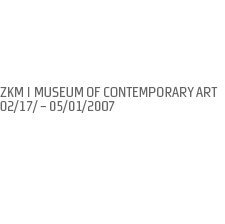
 Part
I_Expanded Paint Tools Part
I_Expanded Paint Tools

 Works in the Exhibition | Works in the Exhibition |  Interview Interview

Works in the Exhibition

7341, 1996, 1996, c-print, acryl
2508, 1997, 1997, c-print, acryl
4328, 1995, 1995, c-print, acryl
3640, 1999, 1999, c-print, acryl
8246, 2000, 2000, c-print, acryl
7127, 2003, 2003, c-print, acryl
4013, 2002, 2002, c-print, acryl
2613, 2004, 2004, c-print, acryl

Interview

Jan Seewald: With the exhibition series Imagination Becomes Reality the Goetz Collection is seeking to widen our understanding of contemporary art. You, and other artists, are participating in the first part of this series, entitled Expanded Paint Tools. This subtitle alludes to the fact that for many years now artists have cast aside traditional notions of painting and have been working with new artistic techniques and tools. Your tools are the camera and the computer, although in your work aspects of sculpture, painting and photography all come together.(1) Would you say that concepts such as 'painting', 'sculpture' and 'photography' are slowly but surely dissipating? Do we need a new terminology?
Jörg Sasse: I donít actually feel that we need new terms. I don't think it's very useful trying to make these differentiations using only classical notions of genre, it leaves you too dependent on the dictates of existing categories. There's scarcely an artist who isn't working in more than one discipline. As I see it, this whole question comes from art historiansí love of interpreting and sorting. There are different ways of getting to grips with chaos of whatever kind, or with something you donít understand. One is to see whether it's possible to sort the material. Of course there are other ways too. Like reproducing Ė- if possible - what cannot be grasped. For instance, someone throws 500 matches onto a writing desk and you try to recreate what you see with another 500 matches. This quickly leads to conclusions that you would never arrive at from trying to sort the matches. Which have got small heads? Which have long heads? Which are damaged? Which are made from perfect pieces of wood? Could you even find that in a selection of 500? But if you try to replicate the chaos, you'll learn something about structures. By trying to duplicate what you see you'll discover the unique qualities of the existing heap. It's unique not for the fact that at first sight itís incomprehensible and you can't have a real overview of it, but for the way it was constructed, in this case by chance alone.
(1) See Annemarie Hürlimann, In der Schwebe, www.c42.de/aharc.html: "[Sasse's] working method is like that of the sculptor in its use of reduction, like that of the photographer in its manipulation and retouching, like that of the painter in the mixing of colours, yet his tools are not chisel, camera or brush but mouse and monitor, which open up yet more artistic possibilities. A loosely or densely Ďwovení web of pixels covers the entire picture surface and makes it unevenly porous or compact, makes forms and motifs appear sharp or blurred, colours bold or flat, so that you have the feeling the picture is either just emerging or already disintegrating."
Text excerpt »Matches, Discarded Household Items and van Gogh« - A Conversation with Jörg Sasse in Düsseldorf, April 2005
(Author: Jan Seewald), Exhibition Catalogue Imagination Becomes Reality Part I_Expanded Paint Tools

|





